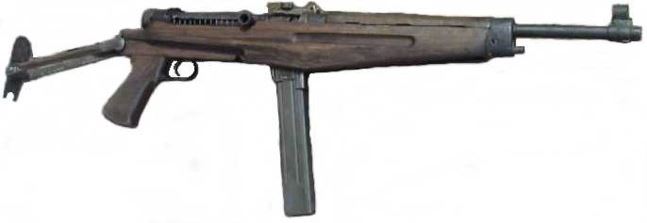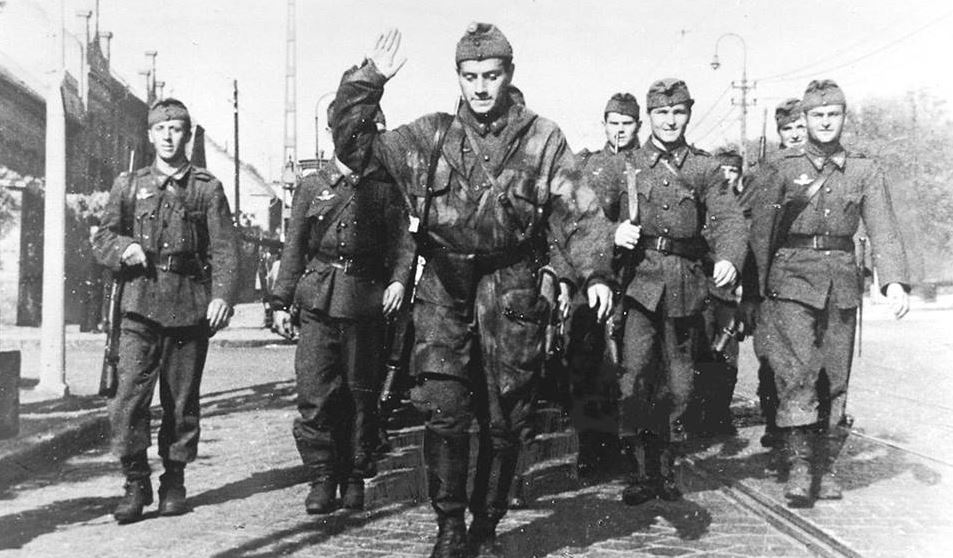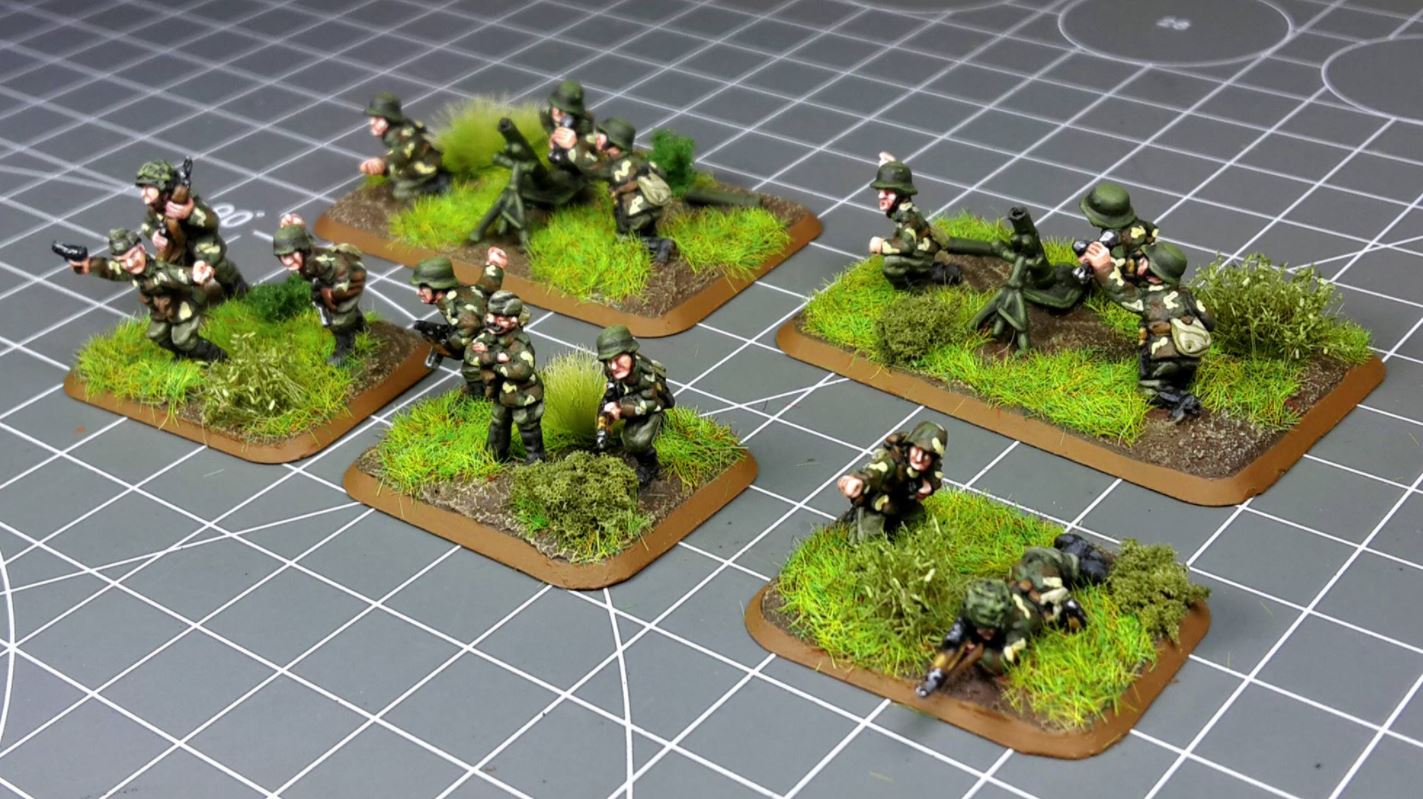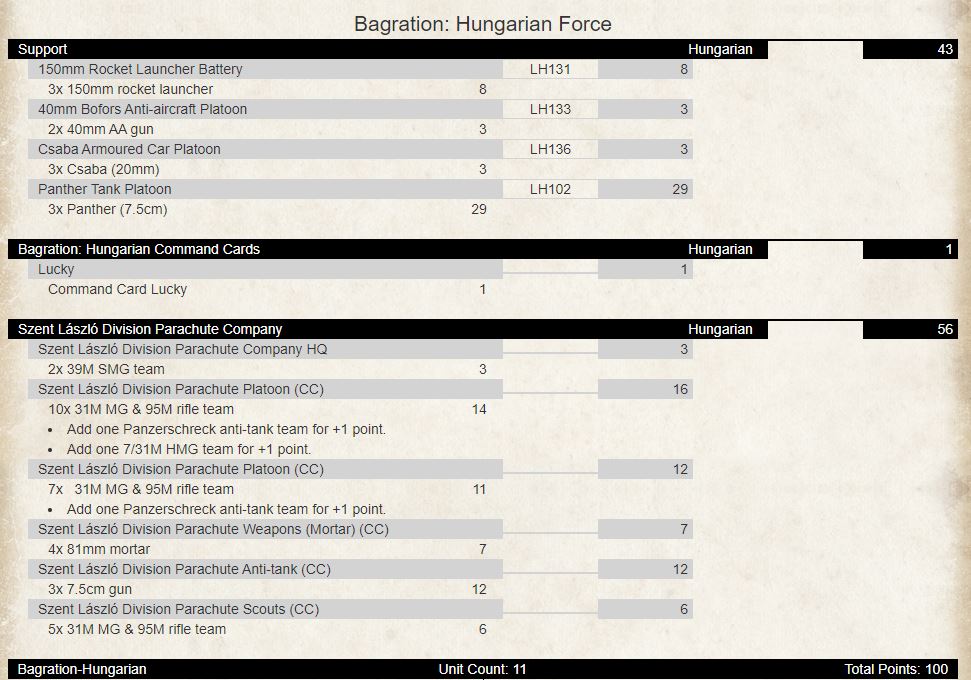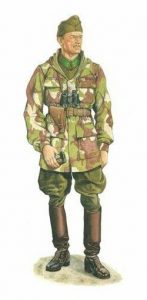
Throughout my time playing Flames of War, I’ve found I have been particularly attracted to minor or unique units and Nations, ones that had been left out of the main history books and the most easily found sources. So I became interested in the Eastern Front Axis Allies in the previous Eastern Front books, like Grey Wolf for late war, and the Ostfront book for mid war. One day a friend of mine put up a picture on the Flames of War Facebook page, of a Hungarian officer in what I thought was a striking 3-tone camouflage jacket, and it got me very interested. This was the start of me going down the rabbit hole of the little known WW2 Hungarian Paratrooper Battalion.
The Hungarians were looking at incorporating Paratroopers into the Royal Hungarian Honvéd ( Honvéd means Defender of the Homeland, and is used in place of Army or Landwehr) as early as 1938, they were developing this independently of the Germans, but were aware of the Germans secretly trying to develop their own Fallschirmjager Forces. These troops were envisioned essentially as a kind of early elite special forces unit, to jump offensively into enemy territory to take command and communication centres, and to harass and slow enemy units.
As a result of WW1, Hungary had lost much land, that was turned into countries like Yugoslavia and Czechoslovakia, and there were many people living in those lands who considered themselves ethnically Hungarian, much like the ethnic Germans or Volksdeutche in similar areas that encompassed the older Austro-Hungarian Empire, that had been stripped in the Treaty of Versailles.
Many young men from the area with language skills and woodsmen or outdoors experience were enlisted to form para-military units, and trained in demolition, small arms, hand to hand fighting, map reading, navigation and survival, as well as how to drive vehicles and jump from planes. There was some fighting in Lower Carpathians in 1938 with a Hungarian para-military unit called the Rugged Guard, and guerrilla style fighting with Czech troops over a disputed area that was eventually given to Hungary after the German annexation of Czechoslovakia in 1939 with the reclamation of the Sudetenland. The soon to be new commander of the Hungarian Paratroopers, Captain Vitéz Bertalan, had been fighting there successfully, he was a WW1 veteran, who had led many raids behind Italian lines at night, as well as aggressive reconnaissance and capturing enemy prisoners, and a proponent of what is now called Asymmetric Warfare. He would leave the fighting there in 1938 to help form the new Hungarian Paratrooper School, bringing the skills and tactics learnt from his years of fighting with him, but at the age of 39.
Initially knowing the Germans were attempting the same thing with the Fallschirmjager, they attempted to get support for their own program from the Germans, such as training, equipment (parachutes), jump procedures and tactics, but the Germans refused all requests. So they developed their own program from trial and error and their own limited experience. They purchased equipment from a variety of nations, they initially had a mix of British, Italian, German parachutes, and on their first jump from an obsolete Italian bomber, a Caproni CA-101 they had a 50% injury rate, with most injuries being the paratroopers breaking their legs on landing.
The issues noted from this include the unsuitability of the Caproni CA-101, which they nicknamed flying coffins, with it being very slow, and only able to carry 6 to 7 paratroopers. The mix of parachutes, causing issues with packing the chutes properly, and standardisation, and the lack of specialist jump gear for the troopers, for example in early jumps they used summer pilot coveralls, with officers boots, which did not support their ankles at all ( so a contributing factor in many broken legs), and also no proper helmets for head protection.
The troops were also trained in WW1 Stormtrooper tactics, with hand to hand combat, mass hand grenade barrages in assault and the use of the M1917 fighting knife, for close assaults. It was clear that they would need to be trained for this type of fighting given their role as elite light infantry, who would need to quickly assault enemy positions soon after landing.
They quickly realised without proper equipment they would be suffering needless casualties, so new planes were bought from Italy in 1939, as Germany was still refusing to help in any way, wanting to keep its elite airborne forces a secret, but Italy which was also developing its own program, would at least help to provide planes. Five Savoia-Marchetti SM.75 Marsupiale (Marsupial) transport aircraft were purchased, which were faster and could take up to 24 paratroopers per plane, they also had a top speed of 369 km/h compared to the 210 km/h of the older CA.101.
Additionally the Hungarians developed their own parachute system, a Hungarian aeronautical engineer Akos Hehs, who had been interested in parachutes, had developed his own parachute system, called the Hehs Parachute or 39M H. Gy Parachute System. It consisted of a dual parachute system, which had a main and reserve chute, which could be opened either by a static line when jumping from an aircraft, or by a pull wire on the harness itself. So it could be used either in mass combat jumps or in free fall jumps, this pre-dated other systems used by the allies, and his patent was bought by the United States in 1941, which they used to develop their own parachutes that were later used by American Paratroopers. This system also introduced the pilot chute system ( or brake chute system), a small chute that opened before the main canopy, which helped controlled opening of the chute and safe landing, similar to a drogue chute in modern parachutes. After WW2 he was brought to the US and helped work on parachutes for the NASA space program.
They also developed a specialised jump suit for their paratroopers, a 1939M one piece jump suit, with zipper opening for easy access, and many pockets in the front and legs to store items like grenades, maps, first aid kits and personal items. The paratroopers like these very much and even though they were only really suitable for jumps, due to limited capacity and lack or camouflage, they were very comfortable and they often even wore them on honour guards or parades, as it showed their elite status.
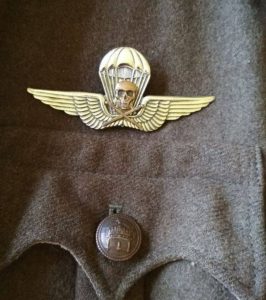
As for as firearms, they were equipped either with the 31M Mannlicher stutzen carbine, ideal for paratrooper jumps due to its short length. Also 37M Frommer service pistols, as a self defence weapon after jumping, which is unusual, as usually only officers get pistols. They also had Solothurn 31M light machine guns, and Solothurn anti tank rifles early in the war for anti tank firepower, which were later replaced with Hungarian produced Panzerfausts when the Germans finally gave them the designs and allowed them to produce them.
They were also equipped initially with the excellent MP35 Bergmann submachine gun from the Germans, until they produced their own submachine gun the Danuvia 39 and 43M sub-machinegun designed by a Hungarian Engineer Pál Király. These were very well liked by the Paratroopers, especially the 34M Király, which functioned reliably in the sub-zero and muddy conditions of the Eastern front. It fired an excellent 9x25mm Mauser bullet with good stopping power and range, it was in fact the largest sub-machinegun at the time that allowed the biggest cartridge and longest range possible from a sub-machinegun. It had a 40 round magazine and a rate of fire of 750 rounds per minute. Later in the war when there was more available, many Paratrooper platoons were equipped entirely with them.
They practiced with their new equipment which performed well, the new SM.75 was a significant improvement from the slower CA.101, and their new chutes performed well. But as usual there were accidents, and several paratroopers were killed in practice jumps, both new recruits and experienced men of multiple jumps. This surely affected the other men training, but the now Major Bertalan found an effective way to inspire confidence in the troops and their equipment. After any fatal accident, he would perform the next jump with the killed paratroopers parachute, to show that they could trust their equipment. This example of confidence and bravery inspired his troops greatly, and they loved him for it, not only was he willing to face possible death with his troops, but he was also quickly approaching 40, showing he would do anything asked of them himself.
Despite all the money and effort put into developing their own equipment and procedures, they only made one combat jump, which was marred by a SM.75 crash on take-off, which killed 17 paratroopers as well as the unit Commander Major Bertalan. It was 1941 and they were going to jump into nearby Yugoslavia to secure a bridge to help with the Hungarian attack into their previous ally. The Germans asked for their help in invading Yugoslavia and in return they would get part of it that bordered Hungary that had ethnic Hungarians, this was distasteful to some Hungarians, with the Prime Minister committing suicide over this betrayal, given they had only signed a Treaty of Friendship in 1940 with Yugoslavia. The five SM.75’s were to take off under full combat load and drop a company from the Battalion to secure a bridge in Szenttamás (now Srbobran, Serbia) to help the Hungarian assault. It was noted that they appeared to be overloaded with paratroopers plus canisters with equipment, but this should not have affected lift off, just a longer take off.
Although the other commanders did not want him to go, Major Bertalan insisted he go, as he was the only combat veteran and was not willing to let him men jump without him. His plane crashed soon after take-off, and with the fuel and ammunition carried it exploded, killing 17 and a huge blow to unit morale, despite this the paratroopers insisted they continue the mission. They were late and landed at dusk, and without maps, which were in the lead plane, and although missing their jump mark they marched the 30 kilometres to their objective and proceeded to take it linking with other Hungarian forces. This was their first successful campaign and although the jump was not a 100% success, the following fighting did show the other good qualities of the paratrooper program, with the paratroopers noted for being excellent close assault troops, bravely taking enemy positions, and excellent espirit de corps. It was found later the crash was caused by improper storage of that plane during winter, which caused the hydraulic elevator trim to not function correctly.
After this there was no other combat jump for the Paratroopers into enemy territory, mostly due to how the war was progressing. They did do some supply jumps in July 1941 to help supply the Hungarian 1st Mountain Brigade, during the invasion of the Soviet Union, they had been advancing so fast they had outpaced their supply units, so were supplied by air. Ten paratroopers jumped in with the supplies to secure them south of Kolomea in the Ukraine, this was their last airborne operation. But mostly the army wanted to keep them back as an elite reserve that did not make most of the officers and NCO’s happy, as they wanted to go join the fight.
Another way for the Paratrooper officers and NCO’s to get experience on the Eastern Front was to be loaned out on three month “tours” as either PT instructors, platoon leaders, NCOs, or close combat instructors. They were well liked by their fellow soldiers as exemplary soldiers that inspired confidence in the troops around them, often getting stuck in with their troops to show them they were not above getting dirty to get the job done.
In 1943 they got their wish and were called up to help stall the Soviet advance on the Oder in Jan 1943 after the defeat at Stalingrad, with the Hungarian 2nd Army being wiped out in the Soviet Little Saturn Offensive. The Hungarians knowing they were outnumbered and with very little effective anti tank equipment, could not hope to hold the Soviet tanks. Despite asking for the release of Corps Cramer which had the remaining few Panzer 38t tanks from the German and Hungarian armoured division and the 168 Infantry Division, the Germans refused, and the Hungarians were pushed back.
The paratroopers were called up to relieve the survivors of the retreating Hungarian 2nd Army, and stalled the Soviets where they could during January and February 1943. This fighting withdrawal stopped them from being over-run and allowed 40,000 of the 200,000 Hungarians who went into the Russia to retreat. Despite huge losses, the Paratroopers gained valuable experience and also proved their worth where they could.
The next major action for the Paratroopers was the fighting around the Carpathian Mountains, in August and September 1944, after Romania defected, and with the Soviets pushing into Hungary. They slowed them down and engaged partisans, and were only then called back to help with the defence of Budapest, but they were already getting a reputation amongst their enemies as excellent assault troops, wiping out many Soviet units in lighting assaults. Unfortunately also the Soviets stopped taking Paratroopers as prisoners, noting their skull parachute emblems and distinctive uniform (perhaps also due to the similarity to the German SS logos).
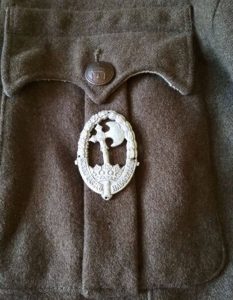
They joined the Szent László (Saint Laszlo) Division in October 1944, which was made up of the best the Hungarians had to offer, which included the Paratrooper Battalion, a bodyguard rifleman battalion, a grenadier regiment as well as dedicated artillery, rocket launchers and assault guns.
The fight that really cemented their reputation was the defence of Budapest, with them being used as fire brigade troops, similar to the German elite formations. It was hard fought, close city fighting, with brave stand around defensive positions, counter-attacks, and eventual retreat again, but always costing the Soviets dearly and helping the morale of their fellow soldiers.
They fought incredibly hard in the defence of Budapest, with them often being used as tank-hunter teams with Panzerfausts against Soviet armour, and their reputation was much enhanced by their ferocity and bravery. In some cases Soviet units fled when counter-attacked by them, leaving their positions and equipment. They would often allow Russian tanks to go through their lines, letting the tanks pass, then pinning the supporting infantry advancing behind them, and then quickly surrounding the isolated tanks and destroying them with panzerfausts. A German officer exclaimed “ If I could get three Divisions of warriors like you boys, I will chase the Russkies back to the Don in three months!”.
If only….. the Siege of Budapest was costing them dearly, when they were pulled out on the 1st of November, the last few days being shelled and shot at by snipers constantly, they had lost in 10 days of defence, 40% of their strength, but had given all the defenders and enemy a strong impression of their skills. They were pulled back to nearby Isazeg, East of Budapest, to what they describe as a terrible defensive position, in full view on a ridge line, that allowed no daytime movement, and were hampered by accurate mortar fire and more snipers, they said it seemed to be what a WW1 combat would have been like. They lost another 10% before being withdrawn completely, with the promise of replacing them with a division, the Germans when told this said “ Keep your Division, and give us back your Paratroopers!”.
They went back to continued to fight after being re-built, and with the new 2nd Parachute Battalion, the force became a Regiment. New recruits from Levant (Youth – 17 to 18 years old) paratroopers, and old hands were used to form the 2nd Battalion, which after a few months of training was thrown into the fight. They both then continued to fight, with the new 2nd Battalion (1400 men) being wiped out on the 27th of December around the town of Ipolyszalka, which the Hungarians call their equivalent of the fighting at Bastogne, but with the opposite result.
The hopeless fighting continued through to January and February of 1945, with the fighting during the day and running at night, to try to outrun the advancing Soviets and surrender to the Western Allies. This continued through to May 1945 where they could finally surrender to the British, with some paratroopers, leaving their unit to try to find their families, the officers let them. Some made it to the British lines and made it eventually to the UK, and Canada, others were put into Soviet Gulags.
Well that was a tale and a half, but well worth it I think, and there are even more great stories to read about, given the amount of new English language sources being published these days both in books and online. So what is the best way to represent these if you want to in game? I would mix German and Hungarian troops to give them a more elite look. When I made mine up I used a mix of Herman Goering Division troops and Hungarian riflemen, so the officers and NCOs were mostly German figures that had boots and forage caps, and also mixed in some German weapons, that they had picked up in the cauldron that was the siege of Budapest. I also gave a lot of them the Hungarian 3 tone, of Khaki, Olive and red brown, to make them stand out. I think it gives you a very distinctive force on the board.
The formation is not in the main book, but as an alternate formation in the Command Card deck, with a lot of other unique units, so I think well worth it to get it. It has a main formation, and some other cards explaining how to upgrade the rest of the units.
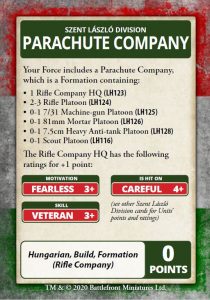
Here is the list I put together, it is mostly based of the main Parachute Company, with some Hungarian Panthers and 150mm Rocket Launchers (Nebelwerfers) as support and my trusty Csaba armoured cars. I also managed to slip in a few Bofors AA guns, but mostly to use against light tanks and armoured cars, or if I’m lucky enough to actually hit something with them in their AA role.
This is meant to be a mostly defensive list, so using the 75mm anti-tank guns, Bofors, and Panthers to restrict the attacking enemies’ movements and funnel them where you want them. A Panther hull-down can do a lot of bullying, with most enemy armour wanting to avoid it, and it also has the mobility to chase them if needed. I would keep the 75mm in ambush if there is an option, rather than the Panthers, and the Panthers have the mobility to move out of a bad area, the 75mm are best used to keep the enemy guessing, and can make a mess of any tank with a good flank shot from ambush.
We also have a large Para Platoon to assault with, and then to hold any objective you take, using the Panzerschrek and the HMG, when you want to counter-attack. Just make sure you bring your HQ to help with those morale rolls!! The smaller one can hold your objective, with the mortars and Panthers. The scout platoon can either hang back to hold another objective, or help take one with the larger platoon.
We have mortars and 150mm Rocket launchers to soften the enemy up, and Scouts and Csaba armoured cars to give you that extra deployment area extension in missions that allow it, make sure you use this, a lot of players forget.

